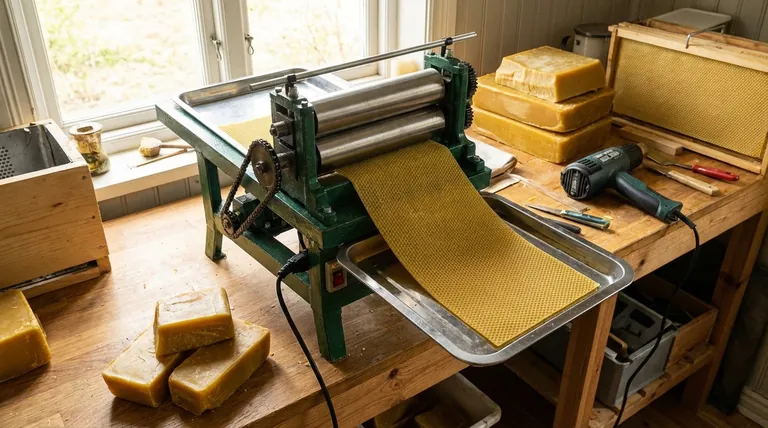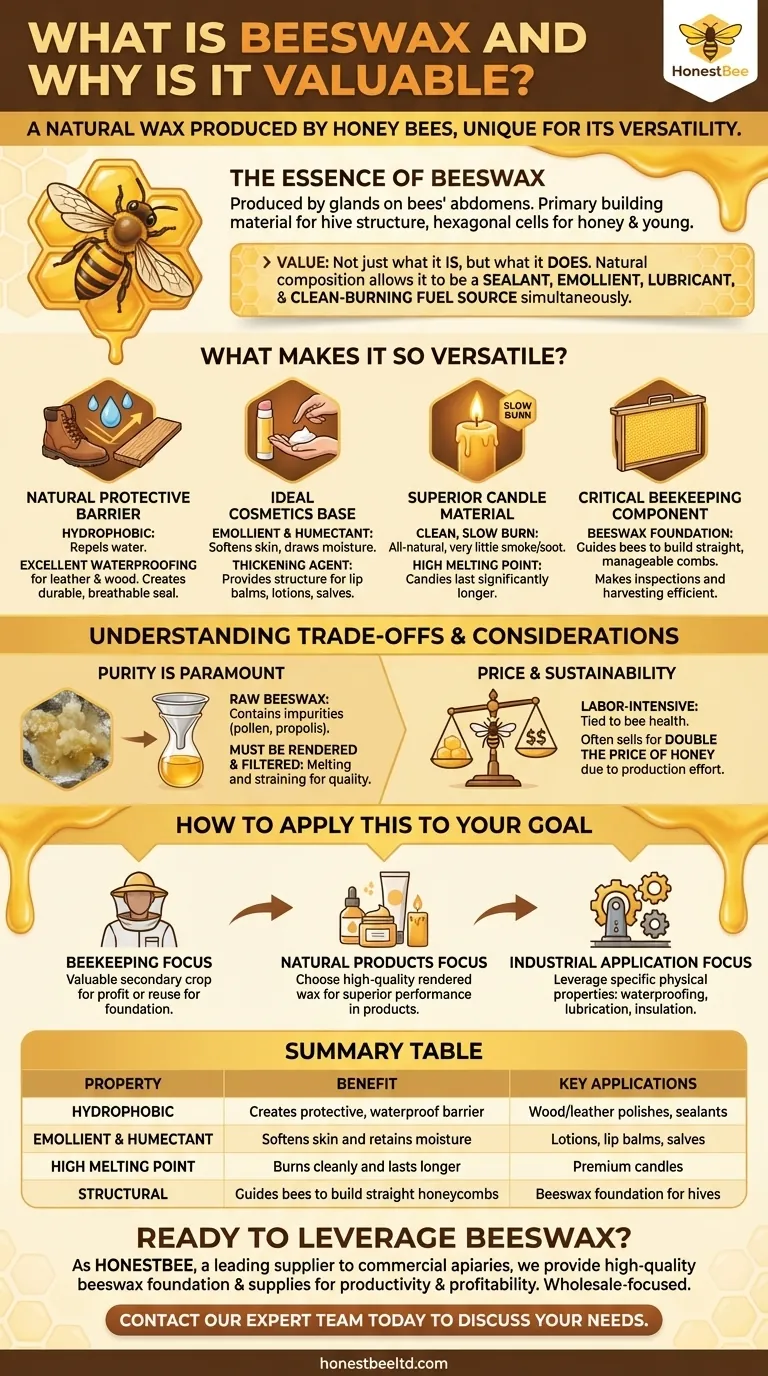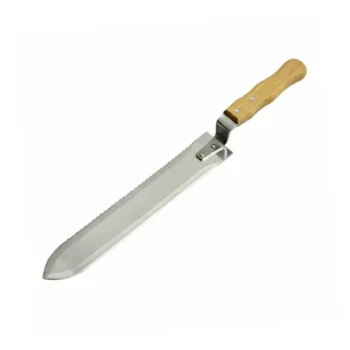In essence, beeswax is a natural wax produced by honey bees from glands on their abdomens. It is the primary building material for the hive's structure, used to form the hexagonal cells of the honeycomb where honey is stored and young are raised. Its value comes from a unique combination of natural properties that make it incredibly versatile for countless human applications, from cosmetics to industrial uses.
The immense value of beeswax isn't just in what it is, but in what it does. Its utility stems from its natural composition, which allows it to function as a sealant, an emollient, a lubricant, and a stable, clean-burning fuel source all at once.

What Makes Beeswax So Versatile?
Beeswax is a complex substance, containing over 300 different compounds. This natural complexity gives it a range of physical and chemical properties that are difficult to replicate synthetically, making it a prized raw material.
A Natural Protective Barrier
One of the most fundamental properties of beeswax is its ability to create a protective barrier. As a wax, it is naturally hydrophobic, meaning it repels water.
This makes it an excellent ingredient for waterproofing products for leather and wood. It creates a durable, breathable seal that protects against moisture damage without using synthetic chemicals.
The Ideal Base for Cosmetics and Skincare
In cosmetics, beeswax acts as an emollient and a humectant. It softens and soothes the skin while also drawing moisture from the air to keep the skin hydrated.
It is also a highly effective thickening agent, giving structure and stability to products like lip balms, lotions, and salves. This prevents them from separating and provides a smooth application.
The Superior Candle Material
Beeswax candles are prized for their clean, slow burn and bright, warm light. Unlike paraffin candles, which are a petroleum byproduct, beeswax is all-natural and burns with very little smoke or soot.
Its high melting point means beeswax candles last significantly longer than those made from other waxes, providing better value over time.
A Critical Component in Beekeeping
Within the world of beekeeping itself, beeswax is indispensable. Beekeepers often use sheets of beeswax foundation in their hive frames.
This foundation provides the bees with a structural guide, encouraging them to build straight, manageable honeycombs. This makes hive inspections and honey harvesting far more efficient. It can also be used as a lure to attract swarms.
Understanding the Trade-offs and Considerations
While beeswax is a remarkable material, its quality and use are not without nuance. Understanding these factors is key to leveraging it effectively.
Purity is Paramount
Raw beeswax harvested from a hive, often called cappings, is not pure. It contains honey residue, propolis, pollen, and other hive debris.
To be usable for most applications, it must be rendered and filtered. This process involves melting the wax and straining it to remove impurities. The quality and color of the final product depend heavily on the thoroughness of this cleaning process.
Price and Sustainability
Beeswax is a direct byproduct of a healthy, productive honey bee colony. Its production is labor-intensive for the bees, and its availability is tied directly to the well-being of bee populations.
For this reason, it often sells for nearly double the price of honey by weight. Its higher cost reflects the effort required by the bees to produce it and the beekeeper to process it.
How to Apply This to Your Goal
Your approach to beeswax will depend entirely on your specific objective.
- If your primary focus is beekeeping: View beeswax not as waste, but as a valuable secondary crop that can be rendered and sold for a significant profit or reused to create your own foundation.
- If your primary focus is creating natural products: Choose high-quality, well-rendered beeswax for its superior performance as a thickener, emollient, and protective agent in cosmetics, candles, and polishes.
- If your primary focus is industrial application: Leverage beeswax for its specific physical properties, such as its ability to waterproof, lubricate threads, or act as a natural insulator.
Ultimately, the value of beeswax is a direct result of its perfect marriage of natural origin and functional performance.
Summary Table:
| Property | Benefit | Key Applications |
|---|---|---|
| Hydrophobic | Creates a protective, waterproof barrier | Wood/leather polishes, sealants |
| Emollient & Humectant | Softens skin and retains moisture | Lotions, lip balms, salves |
| High Melting Point | Burns cleanly and lasts longer | Premium candles |
| Structural | Guides bees to build straight honeycombs | Beeswax foundation for hives |
Ready to leverage the value of beeswax in your operation?
As HONESTBEE, a leading supplier to commercial apiaries and beekeeping equipment distributors, we provide the high-quality beeswax foundation and supplies you need to maximize hive productivity and profitability. Our wholesale-focused operations ensure you get the reliable materials required for efficient honey production and wax harvesting.
Contact our expert team today to discuss your specific needs and discover how our products can support your success.
Visual Guide

Related Products
- Electric Beeswax Flat Sheet Machine with Operating Tray for Wax Processing
- Professional Thermostatic Conical Honey Melter
- HONESTBEE Advanced Ergonomic Stainless Steel Hive Tool for Beekeeping
- Beehive Handle and Frame Rest Cutting Machine: Your Specialized Hive Machine
- Professional Dual-End Stainless Steel Hive Tool for Beekeeping
People Also Ask
- What are the advantages of using industrial wax melters for beeswax? Achieve Scalable, Safe, and Consistent Production
- How does the machine flatten the beeswax? A Guide to Roller and Press Methods
- What is the process for purifying beeswax after removing it from a hive? A Simple Two-Stage Method for Pure Wax
- What are the steps involved in preparing wax sheets for milling? Master Temperature Control for Perfect Foundation
- How do worker bees produce beeswax? A Guide to the Hive's Manufacturing Process



















